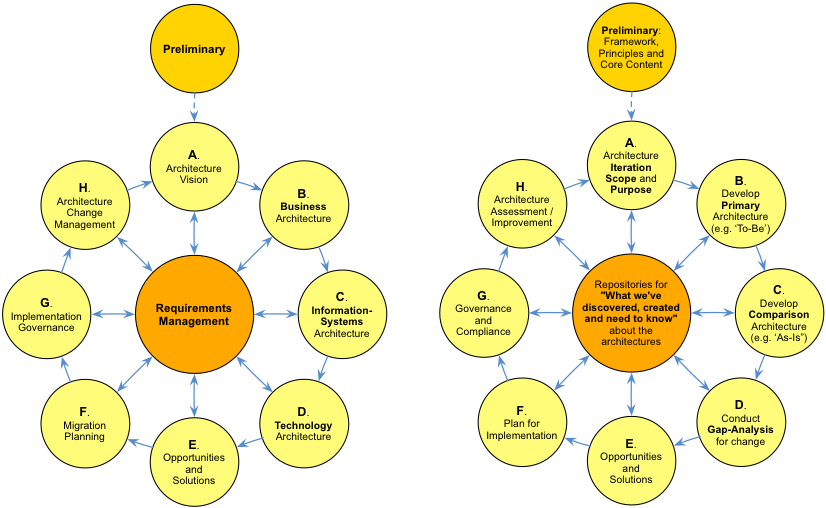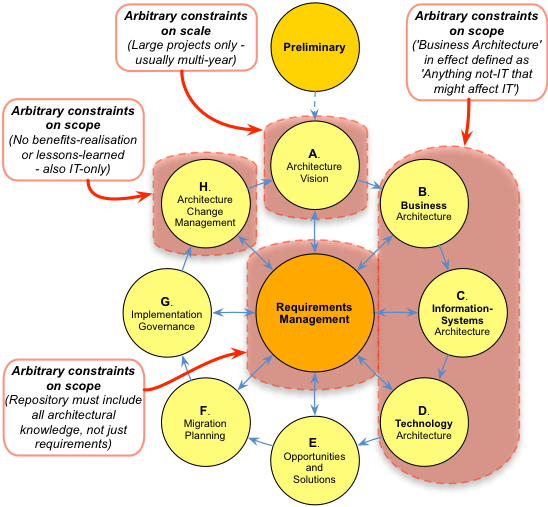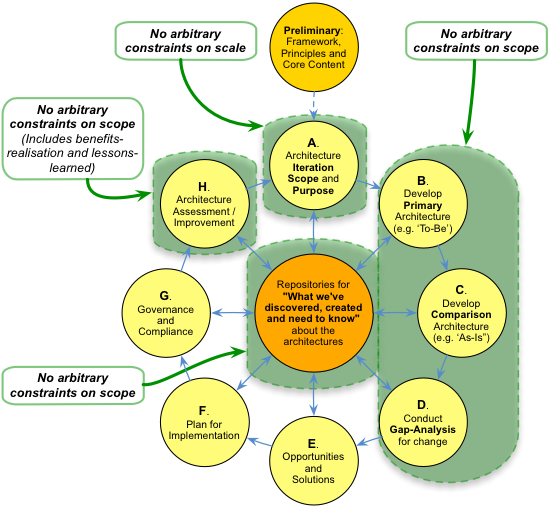The long and the short
Yeah, there’ve been complaints.
— “Write simpler! 🙂 “, says one.
— “You write so looong!”, says another.
— “I have a problem with your blog-posts”, says yet another. “I know I’ll be required to think hard if I read them and reply/comment something intelligent. Therefore, many times I procrastinate and when I come to them, they are oooold… 🙂 ”
Happy complaints, most often, but complaints nonetheless.
So yeah, I gotta fix that…
Catch is that, well, often I do need to write long. No real choice about that. Honest.
For example, if I just want to tell you that the TOGAF ADM is too limited for most enterprise-architecture, well, yes, I can do that, easily, in a few hundred words and a couple of graphics:
And yeah, I could stop there, with a bald assertion and nothing more. After all, that’s all that most people seem to do, on the net and elsewhere…
But it’s not exactly a defensible-argument, is it? Just one person’s opinion. So what?
Instead, to do it properly, it’s not enough just say that the TOGAF ADM is too limited for enterprise-architecture: I must explain why the TOGAF ADM is too limited for enterprise-architecture. In detail, with step-by-step analysis, examples, proof. And preferably with full visual explanation, too, such as:
Versus:
So yes, it really does take 5000 words to do all that. (And a whole swathe of ‘a-picture-takes-the-same-time-to-create-as-a-thousand words’ graphics, too.)
No way round this – not if we want an explanation that even the most obsessive adherents for the respective screwed-up ongoing-disaster-area can’t refute…
Hence, yes, it really does take 12000 words and a lot of graphics to explain why Gartner’s ‘Bimodal-IT’ is too simplistic for real-world use.
Yes, it really does take nigh on 40000 words and a lot of graphics to describe sensemaking-errors such as ‘echo-chamber‘ and ‘priority and privilege‘ and their impacts as societal-scale ‘disservices’, and thence how to mitigate against those impacts in enterprise-architectures.
Yeah, I do know: that’s a blog-post series that’s the size of a small book. Ouch…
But blunt fact is that if we want enterprise-architecture to become a viable discipline, we do need those long posts.
(Which is why, yes, there’ll always be those longer posts here – including, coming up soon, one on why enterprise-architecture needs to be about (much) more than IT; another on why the scope of ‘the enterprise’ in enterprise-architecture needs to be (much) broader than the organisation itself; and yet another on why business-model designs need to be aware not just of value, but anti-value too.)
There’s no way round this – not if we want it done properly.
Sorry.
Yet I do acknowledge that people also need shorter summaries. Simpler, but not simplistic.
Easy to read, quick to read.
Posts that come in at 500 words or less. With graphics too, if need be, but still short, snappy and suchlike.
Like this one, for example.
So yes, I will do more of these from now on.
Much more than in the past, anyway.
I promise.
Fair enough for now? 🙂



I have always found your analysis and insights to be concise, to the point and highly relevant. This topic is highly relevant to my current programme where we find zealots have tried using high level concepts to describe solution architecture. These SAD docs become bloated and verbose… Losing sight of the wood in a plethora of hazy trees.
I’m thinking that model driven system engineering could be placed in the middle of the wheel, from integrating requirements, architecture and design models, feeding development and testing etc.
It gives people a sporting chance to share insights and collaborate using shared models and specifications.
Anyway thanks for the ideas and brain stimulation.
Sian
Tom, it’s not you, it’s the rest of the world… 🙂
I know, a very flippant response, but the reality is that us folk that read online content to keep up with an ever-changing world are assaulted with a dizzying volume and variety of material. As a result, we become quite time poor in relation to any one post.
This highlights a fundamental flaw in the systems and services we use to maintain our knowledge, but also picks up on the issue of “breadth of topic” that many of us feel compelled to have an awareness of (due to the breadth of knowledge required by an EA).
I sense that this topic itself could fill a book (or at least a number of sizeable posts). Ironic perhaps?